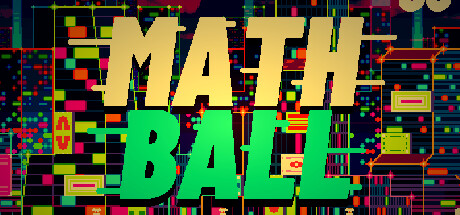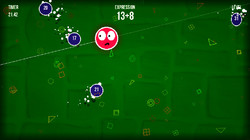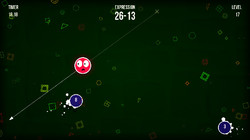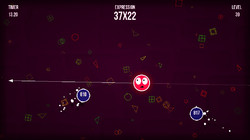Every day we offer FREE licensed software you’d have to buy otherwise.

$1.99
EXPIRED
Game Giveaway of the day — Math Ball
Relax and hone your math skills by solving challenging problems on the go!
$1.99
EXPIRED
User rating:
9
5 comments
Math Ball was available as a giveaway on January 6, 2023!
Today Giveaway of the Day
Test your reflexes and strategy skills in this classic arcade game!
"Math Ball" - a game where you can relax and hone your math skills by solving challenging problems on the go, dodging wrong decisions, and running out of time!"Math Ball" is a game with solving mathematical problems that become more difficult with each passage, and time is limited and all that remains for the player is to make lightning-fast decisions and show all his dexterity and attentiveness.
Game Features:
Cool visual style
Maths education
Increasing difficulty.
System Requirements:
Minimum: Windows XP; Processor: Core2Duo; Memory: 512 MB RAM; Graphics: Intel HD Graphics; Storage: 50 MB available space
Publisher:
Sweety BoyHomepage:
https://store.steampowered.com/app/2214730/Math_Ball/File Size:
105 MB
Price:
$1.99
How would you improve Math Ball?
No similar feedback found. Feel free to add yours!
GIVEAWAY download basket
Developed by BeamNG
Developed by SCS Software
Developed by Overwolf
Developed by Rovio
Comments on Math Ball
Thank you for voting!
Please add a comment explaining the reason behind your vote.
Please add a comment explaining the reason behind your vote.
iPhone app giveaways »
$0.99 ➞ free today
$0.99 ➞ free today
A simple and native YouTube client for iOS with no ads, picture-in-picture, and background playback.
$0.99 ➞ free today
$0.99 ➞ free today
"Task and Habit Tracker" is a software application that provides users with tracking tasks and habits.
$0.99 ➞ free today
Android app giveaways »
Booksonic is a platform for accessing and streaming the audiobooks you own wherever you are.
$3.00 ➞ free today
The must try game for any real hack and slash fan who already got bored with just mindlessly smashing buttons.
$0.99 ➞ free today
$15.99 ➞ free today
$0.99 ➞ free today
Word mania is a game of words. It contains seven mini word games and over 7000 word puzzles to boost up your brain.
$6.49 ➞ free today






Save | Cancel
Notes to the developer:
I liked the game. It has simple graphics but it helps in mental mathematics. And I'm sure if children play Math Ball often enough they will soon excel at mental math calculations!
However, I found it really frustrating that my bubble keeps getting bigger when some other bubbles bang into it. Many children will stop playing this game because it seems unfair that they lose because other bubbles are banging into their bubble. But, I can understand that the bubble becoming bigger is part of the challenge, so I have a few tips to the developer:
1) MOST IMPORTANT: It's OK for the bubble to become bigger when some other bubbles hit it (or when I hit the wrong bubble). But, as I said, it is frustrating that the bubble becomes bigger sometimes due to no fault of mine. So, to make it fair, the bubble should become one size smaller every time I hit the correct bubble.
2) You begin with simple addition and subtraction, and then after a few levels, we get slightly more complex additions and subtraction problems. And then, it suddenly shows a 2 digit by 2 digit multiplication! Instead, just as you do for addition and subtraction, can you also introduce the multiplication levels slowly too? That is, first have some simple 1 digit problems (like, 4 x 9, or 3 x 7, etc.), then add 2-digit items into the mix (like, 6 x 12, 7 x 17, or 3 x 14, etc.), and then after a few levels, bring in the 2-digit x 2-digit sums (like 14 x 12, 17 x 16, etc.)? Again, after a few levels introduce 3-digit x 1-digit (like 203 x 5, 634 x 2, etc.), followed by 3-digit x 2-digit, and later 3-digit x 3-digit (at really advanced levels or later stages of the game)
This way, there are two advantages:
a) Younger players can play the lower levels and slowly move on to higher levels as their knowledge of multiplication levels increases. (As someone else suggested here, once the two-digit problems start appearing, parents can restart the game for younger players.) This also gives younger players an incentive to improve their learning of the multiplication tables.
I don't know whether you have division problems too. But, there too, you could start simple and slowly increase the complexity.
b) Even for more senior players, it is easier to slowly gear up to larger sums instead of suddenly jumping to a 2-digit x 2-digit multiplication some.
3) Introduce a HIGH SCORES screen. When the game ends for a player, show them their score and ask for their name. This name and score should appear in the High Scores screen.
This too has advantages:
a) It provides an incentive to a player to keep trying to improve their score.
b) It allows the player to proudly show off their mental math capabilities (which is a good incentive for young players).
c) It allows players to compete with friends or other family members. Which will make the game more fun!
I hope you will incorporate these suggestions in the next version of the game.
Regards,
Sunil
Save | Cancel
Sunil Suresh,
Save | Cancel
https://files2.giveawayoftheday.com//MobiKin/MobiKinDoctorforios25-tr45ar.zip?hash=b702a13ab6d98ce7e219977b10a29b9a
https://files2.giveawayoftheday.com/SweetyBoy/MathBall-pf95uf.zip?hash=1ecee68417b49fccad5ec5f070ce4507
503 Service Temporarily Unavailable
Save | Cancel
legheraba,
Save | Cancel